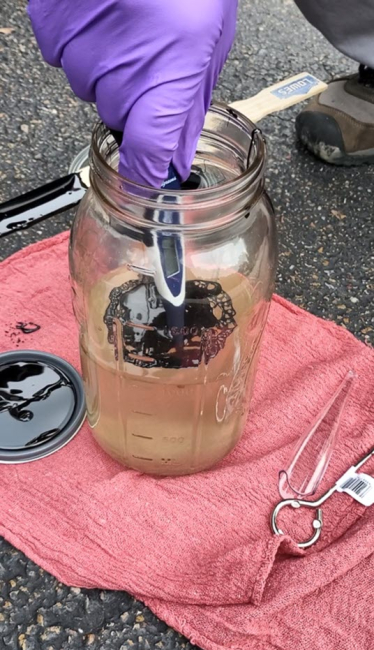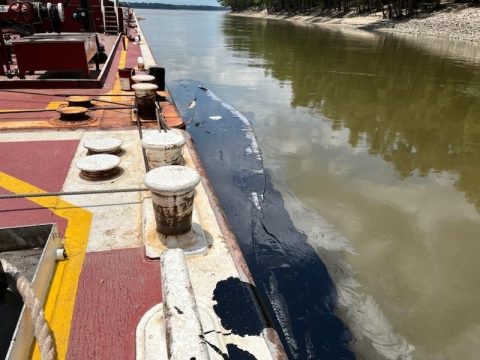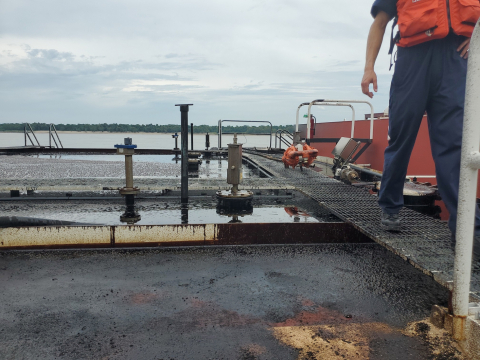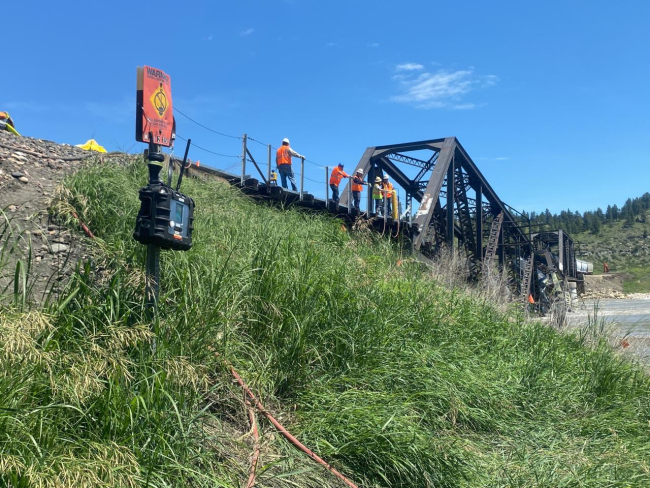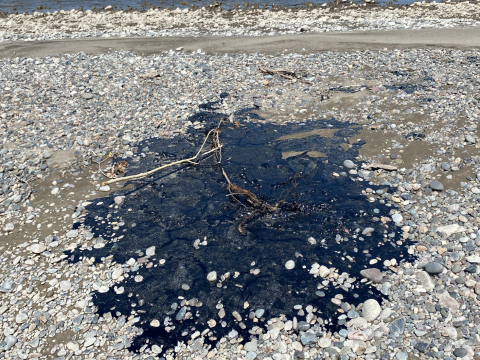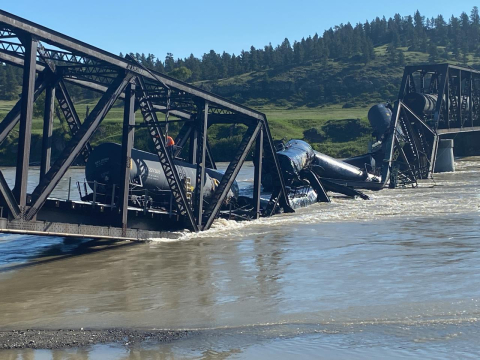Every month, OR&R’s Emergency Response Division provides scientific expertise and services to the U.S. Coast Guard, ranging from running oil spill trajectories to estimate where a spill may spread; to identifying possible effects on wildlife and fisheries; to estimating on how long oil may stay in the environment. We also get requests to track and model other floating objects, such as log booms or shipping containers that have broken free, whale carcasses, fish die-offs, and algal blooms.
So far this year, OR&R has provided support for 77 incidents. During June 2023, OR&R provided response support for 17 incidents, including 12 new incidents in 10 different states.
The 12 new incidents included 10 oil spills, and one potential oil spill (a vessel that grounded but did not spill oil), and one chemical incident. The chemical incident involved a railroad bridge collapse that resulted in 10 railcars laden with hazardous materials falling into the Yellowstone River in Montana. Because this spill occurred inland, our work supported the U.S. Environmental Protection Agency, rather than the U.S. Coast Guard.
OR&R staff prepared 98 new incident reports and documents, including nine fate and trajectory analyses. Cumulatively, these incidents posed an approximate risk of more than one million gallons of oil, 168,000 gallons of molten sulfur, 84,000 gallons of molten asphalt, and 36,000 gallons of sodium hydrosulfide.
(Note: All spill volumes are approximate and based on initial information that may be updated after further investigation.)
Here are some of June’s notable incidents:
Discharge of Asphalt-like Oil into Mississippi River at MM 339, Ashland, LA
On June 11, 2023, NOAA OR&R was contacted by the U.S. Coast Guard (USCG) Sector Lower Mississippi River regarding the discharge of approximately 5,000 gallons of an asphalt-like oil into the Mississippi River. The discharge was reported to have occurred at around 8:00 pm on Saturday, June 10 and was secured at the time of report.
Pollution responders from the Coast Guard Marine Safety Detachment Vicksburg and Sector Lower Mississippi River were deployed to assess the situation on the scene. At the request of the USCG, OR&R provided resources-at-risk and initial fate and effects analysis. Two scientific support coordinators deployed on scene to support the response.
The discharge originated from a Kirby Inland Marine barge being transported by the towing vessel Leviticus at mile marker 339, a few miles downstream from Natchez, Mississippi, around 10:00 pm on Saturday. The crew of the Leviticus secured the source of the discharge and estimated that approximately 3,402 gallons of high-temperature oil entered the water. An additional 1,000 gallons were also discharged, but were contained to the deck of the barge.
Responders from Kirby and private spill response companies were on-scene early Sunday morning to conduct initial assessment, investigation, and begin clean-up operations. Hard and sorbent boom were deployed to contain the product in the water, and at that time, an estimated 800 gallons of oily water mixture had been recovered, with no reports of wildlife impact. A USCG on-scene survey of shoreline on June 12 noted that a significant amount of oil was still floating on the surface between the two barges.
When specific information about the type of oil spilled is unavailable during a response (such as in this incident), OR&R scientists sometimes make simple observations or conduct a “tailgate” test of the spilled oil. The test can help determine if an oil will float and its relative viscosity. It can help predict the oil’s behavior, help us predict how it might weather (i.e., change in physical and chemical properties) over time, assist in estimating its persistence in the environment, and in determining the range of appropriate response actions and potential environmental impacts.
The tailgate test done at this spill provided some interesting results. The OR&R science team expected the heated liquid asphalt to sink as it cooled; however, it did not, it floated. The oil product was determined to be a refined oil residue with a specific gravity just less than water, allowing it to float. Oil was found on (and skimmed off) the river surface, and oil blobs were found miles downstream. None, however, were found on the bottom when surveyed with sonar equipment. Additional spilled-oil samples were delivered to labs at USCG and OR&R's contract oil chemistry lab at Louisiana State University for more detailed chemical analysis.
The cause of the discharge is currently under investigation, with remote support from the NOAA SSC continuing, as needed.
Train Derailment, Yellowstone River, Reed Point, MT
On June 24, 2023, NOAA OR&R was notified of a rail car derailment near Reed Point, Stillwater County, Montana. The NOAA scientific support coordinator (SSC) contacted the On-Scene Coordinator for the U.S. Environmental Protection Agency (EPA), who requested a spill trajectory with oil fate and effects.1
OR&R spill scientists evaluated the oil density and particle (asphalt glob) size compared to river flow estimates, to determine how the oil would behave and how far downstream it might flow. A stream flow tool from the U.S. Geological Survey supported OR&R’s conclusions about timing and distance. Also, based on river flow dynamics, OR&R was able to provide the shoreline assessment teams with locations where stranded or pooled oil could accumulate.
Montana Rail Link reported the collapse of the Twin Bridges bridge, which resulted in the derailment. The impacted rail line included 52 total cars, 17 of which derailed, and 10 of which entered the Yellowstone River under the Twin Bridges bridge. The 17 derailed cars contained sodium hydrosulfide, asphalt liquified petroleum, molten sulfur, and scrap metal. The sodium hydrosulfide cars did not enter the river.
In addition to EPA responders, representatives from the Montana Dept. of Environmental Quality, local law enforcement, fire department, Fish & Wildlife Services, and Montana Disaster & Emergency Services arrived on scene. Also supporting the EPA are technical contractors who helped coordinate environmental assessment and response activities with state and local officials. The spill response included removing the rail cars from the river and transferring the product from the remaining asphalt cars into stable rail cars; determining the amount of molten sulfur and liquid asphalt petroleum released from rail cars; beginning Shoreline Cleanup Assessment Team (SCAT) surveys of the response area; and removing asphalt material from shorelines. This work is extensively documented, including many photos, in the EPA’s Stillwater Train Derailment profile site.
OR&R’s Spatial Data Branch plotted locations and photos of asphalt patties in NOAA’s online mapping program ERMA® (Environmental Response Management Application). Observations covered the stretch of river from the incident to approximately 85 miles downstream (30 miles northeast of Billings).
OR&R continues to be available for scientific support, such as resources at risk, and recently provided recommendations for detecting potentially submerged oil.
Response to Liquid Asphalt Releases in Aquatic Environments: Results of a 2009 Workshop held at the Coastal Response Research Center (CRRC), a partnership between NOAA, through its Office of Response and Restoration (OR&R), and the University of New Hampshire. It provides links to numerous presentations and resources related to liquid asphalt releases.
1 While the U.S Coast Guard (USCG) has primary responsibility for cleaning up oil spills in coastal regions and the Great Lakes, the EPA has that responsibility for inland spills. As per the National Contingency Plan, NOAA SSCs can provide scientific support to USCG or EPA.
Here is the complete list of June's incidents. Click on the links to find out more:
- 108’ Vessel YTB823; Brownsville Marina, WA
- Tarballs Reported on Sargent Beach, Bay City, Texas
- Train Derailment, Yellowstone River, Reed Point, MT
- Satellite Report Indicates Potential Oil Slick, Fort Lauderdale, FL
- Oil Anomalies Detected by Satellite Imagery, SE Alaska
- Commercial Fishing Vessel Hard Aground, Horn Island, MS
- Tanker Truck Explosion/Fire Leads to Collapse of I-95 Overpass, Philadelphia, PA
- Discharge of Asphalt-like Oil into Mississippi River at MM 339, Ashland, LA
- Sheen Discharging Near Abandoned Platform in High Island Block 24, Jefferson County, TX
- Sheen from Sunken Fishing Vessel in Five Fathom Creek, McClellan, SC
- Storage Tank Fire at Refinery, Lake Charles, LA
- Damaged/Leaking 55-gallon Drum, Shishmaref, AK

